Background
- Powder River Petroleum International, Inc. is a company incorporated in Oklahoma.
- The sector of operation is energy.
- The company primarily markets, acquires, and produces natural gas and crude oil properties.
- The company was founded in 2000 and started by registering securities for small and medium businesses.
- A PCAOB-registered audit firm auditing Powder River Petroleum International, Inc. is Chisholm, Bierwolf, Nilson & Morrill, LLC.
- The firm failed to conduct the company’s audit according to PCAOB Standards and Rules.
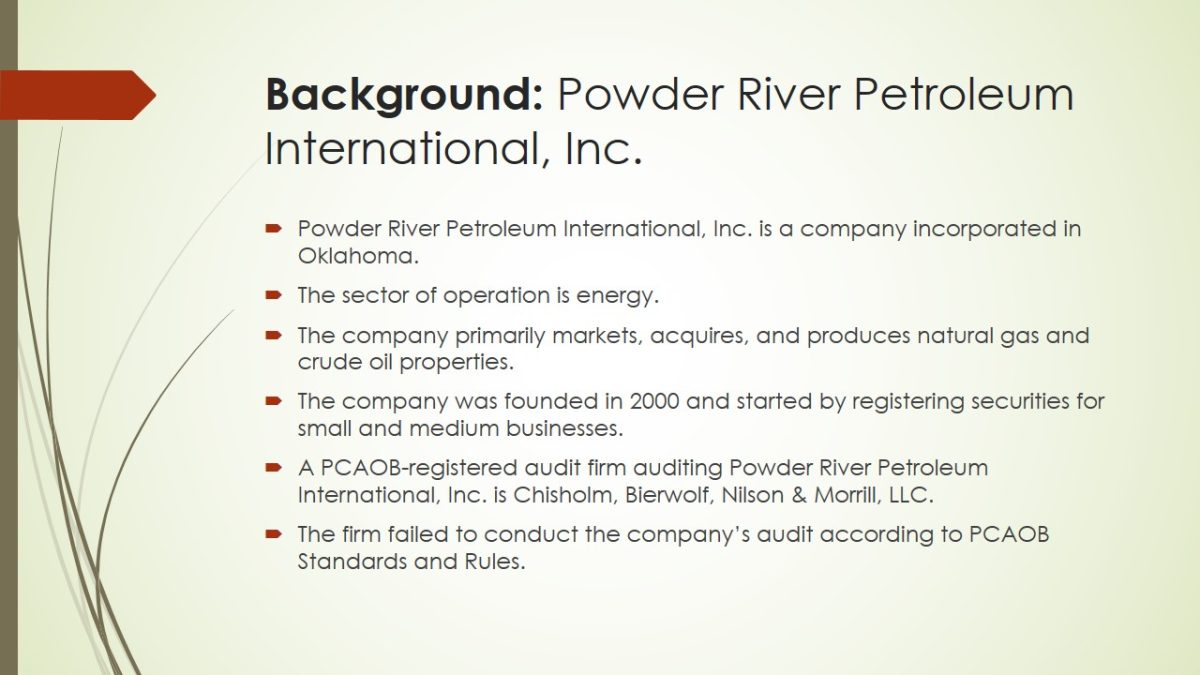
Expectations
- Powder River Petroleum International, Inc. promised its Asian working interest investors a guaranteed return on their initial investments.
- The company was expected to properly account for its conveyances.
- In addition, the company was expected to conduct its financial activities in accordance with general accounting principles by correctly recording its assets.
- Chisholm, Bierwolf, Nilson & Morrill, LLC was expected to exercise professional skepticism and care, and gather sufficient evidence for its conclusions.
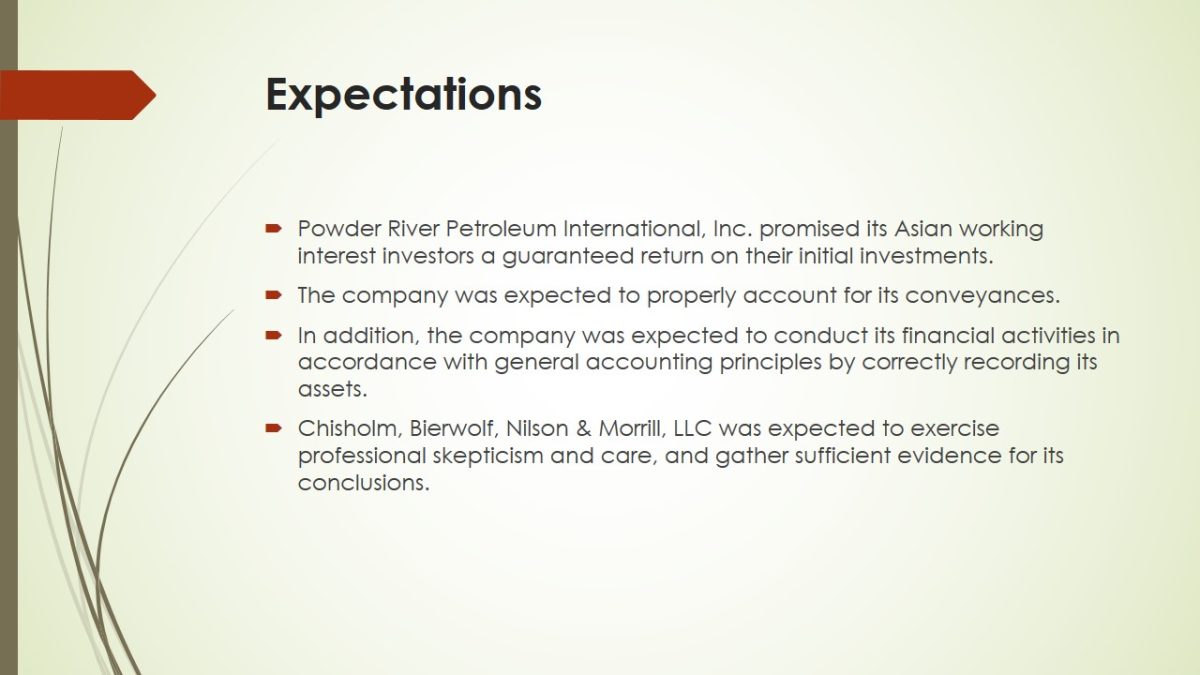
Violations
- Since 2004 until 2008 Powder River Petroleum International failed to properly account for approximately $43 million to its Asian investors.
- The company promised a guaranteed return on the investments, but immediately recognized revenues, and thus, dismissing their own promise.
- The financial statements did not properly present cash flows, operating results, and company’s financial position.
- The auditing primarily overstated the company’s assets, pre-tax income, and revenues by a significant margin.
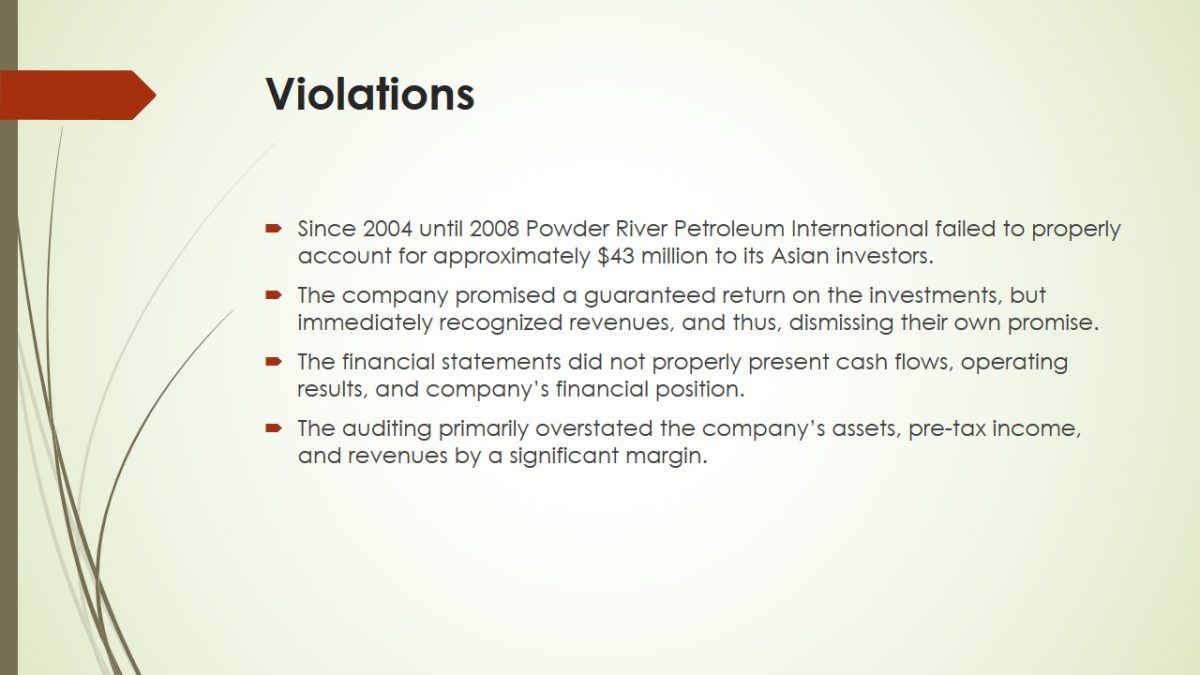
Risk Factors and Working Interests
- One of the main risk factors is fraudulent revenue reporting.
- Major liabilities were omitted.
- Assets and revenues were inflated.
- Revenue values were assessed without recognizing the guaranteed payments in working interests.
- Working interests needs to be reported according to Schedule C, which focuses on depletion, expenses, and receipts.
- Working interests and guaranteed payments need to be accounted in conjunction with the company’s direct and indirect operating expenses.
- Working interests are directly tied to net revenue, which means that inflated revenue will change the former value.
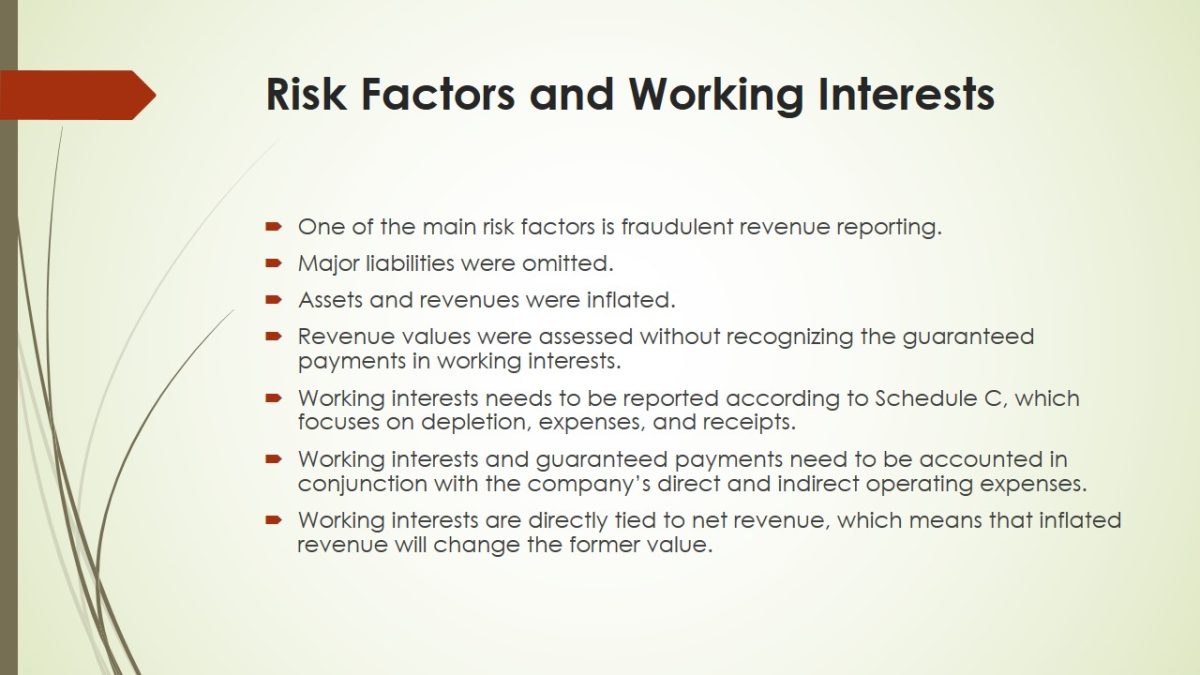
Management Assertions
U.S. auditing standards identify the principal “management assertions” that underline a set of financial statements. What management assertions were particularly relevant to the “sales” of working interest and the guaranteed payments made annually by Power River to the purchasers of those working interests?
The management assertions are:
- Accuracy, Classification, Completeness, Cutoff, Existence, Occurrence, Rights and Obligations, Valuation, Understandability.
- In case of the working interests, the Accuracy management assertion is particularly relevant, because the fact that revenues were inaccurately reported changed the value of these interests.
- In case of guaranteed payments, the Right and Obligations assertion is relevant, because the company was obliged to fully disclose these correct amounts to the investors.

Fraud
- CBN failed to correctly report the assets owned by Powder River Petroleum International.
- The assets that were not owned by the company were reported as owned ones.
- The given oversight constitutes to fraud, because there is a high probability that the auditing firm knew about these particular assets, but still reported them as owned.
- This would be considered as negligence if the case did not involve a number of other fraudulent activities, which implies that there was an intent to deceive the investors.
The identification of fraud and its prevention is a paramount task, which is set by the owners of the organization to internal and external auditors. This is due to the fact that in conditions of uncertainty and risk, internal audit in the corporate governance system of the company is an effective tool for identifying fraud, according to which internal auditors can interactively respond to risks that affect the return on equity, as well as develop draft decisions to prevent fraud in key business processes. It is important to highlight the main tasks that are set before auditors in the process of identifying corporate fraud. This is a definition of corporate fraud status; analysis of types of fraud; determination of the most significant factors causing fraudulent actions, and the establishment of their causes; analysis of sources of fraud; and identifying the most effective methods to combat corporate fraud.
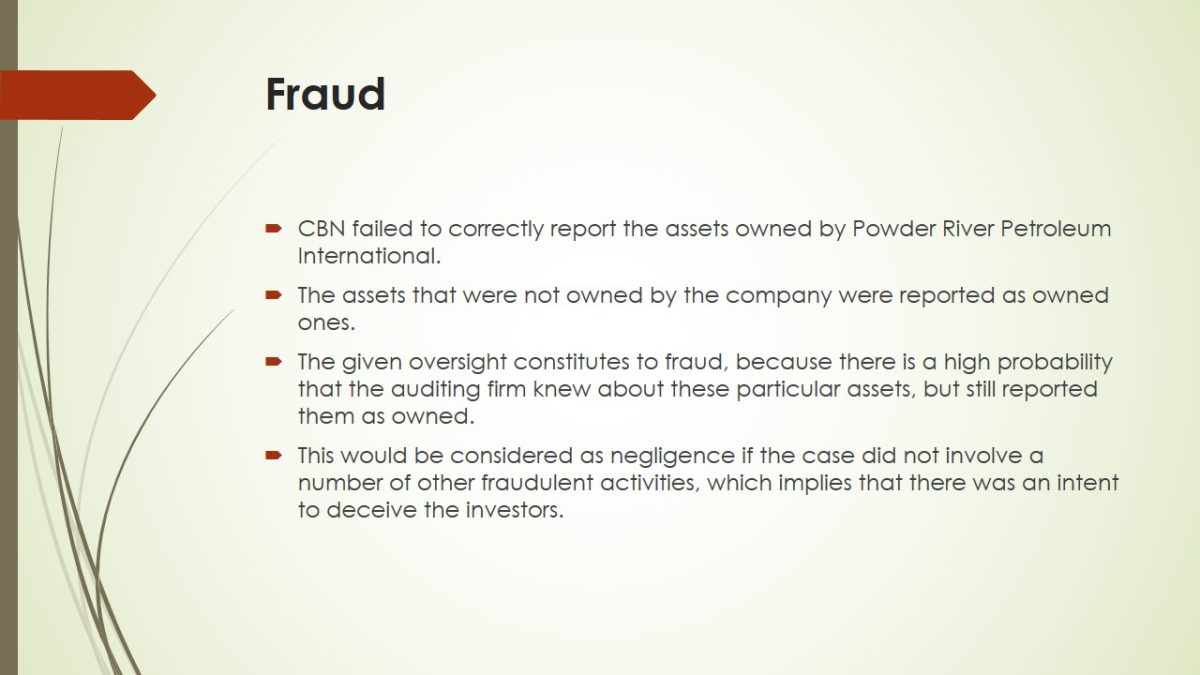
U.S. Auditing Standards
- The primary standard that was dismissed is PCAOB Auditing Standard No. 3, which is called Audit Documentation. The firm failed to correctly prepare the documentations of auditing procedures.
- The PCAOB standard of AU 326 Audit Evidence was not followed, where there was an insufficient amount of evidence regarding revenue and assets.
- The PCAOB standard AU 230 Due Professional Care in the Performance of Work was not followed, because the “red flags” were not recognized.
- The PCAOB standard AU 336 Using the Work of a Specialist was not followed, where the competence and qualification of petroleum engineers were not assessed regarding their validity as an audit evidence.
For the successful implementation of the process of identifying signs of fraud in the corporate governance system, methods have been identified and the features of their application by internal auditors have been clarified, namely: mathematical methods; statistical methods; analytical methods; documentary methods; control methods; computer methods; psychological methods; expert or informal methods; control of behavioral reaction. Using these methods will allow internal auditors to identify fraud and investigate the causes of its occurrence in the organization’s corporate governance system, taking into account the factors affecting the external and internal environment on the subjects of fraud.
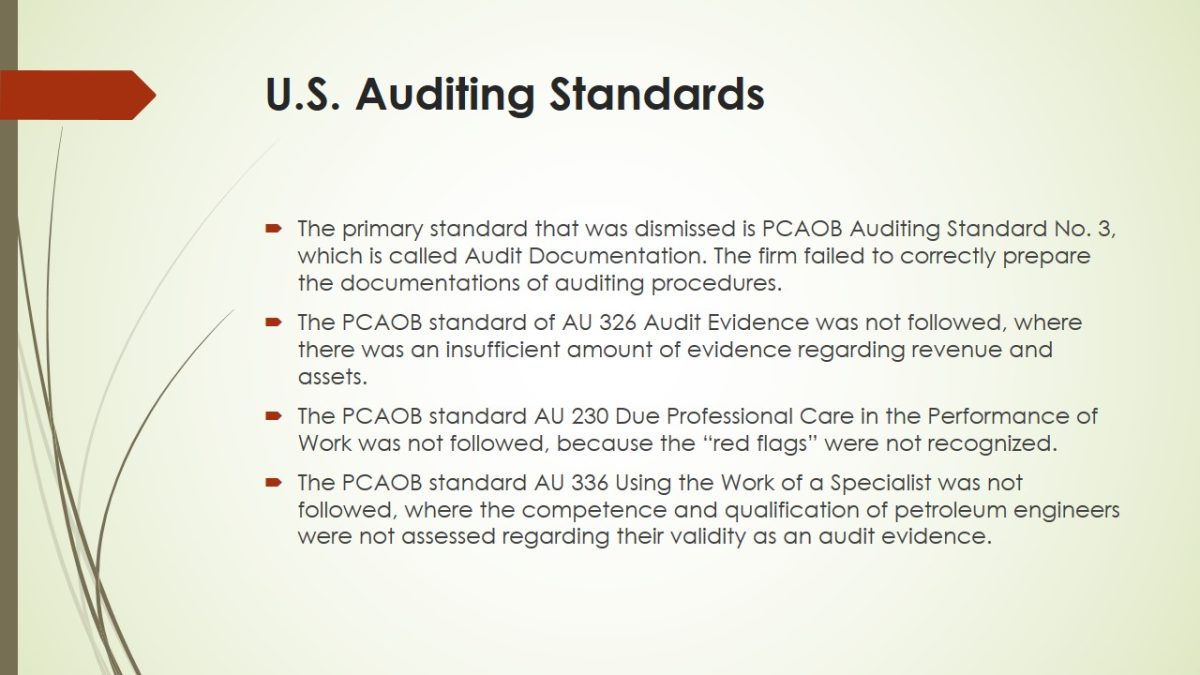
Quality Control
- The primary issues of the quality control system regarding public companies are ethical requirements for the leadership, risk assessment, proper documentation, engagement performance, and monitoring.
- CBN failed to correctly document the auditing process by providing inflated revenue values.
- Risk assessment was not properly conducted, where unowned assets were included and liabilities were omitted.
- CBN also failed to monitor the company’s quality control policies regarding ethical standards.
The presence of an internal audit in the corporate governance system, if properly organized and carried out in accordance with the approved mission and development strategy, enables internal auditors to: timely identify signs of fraud and further develop draft decisions on its prevention; create anti-fraud projects at different levels of the organization’s corporate governance system; provide top management of the company with guarantees that the decision-making process and business operations do not contain signs of fraud.
